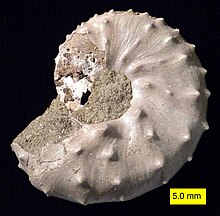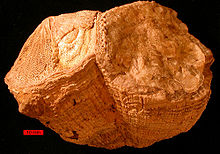Extinction patterns[edit]
The blue graph shows the apparentpercentage (not the absolute number) of marine animal genera becoming extinct during any given time interval. It does not represent all marine species, just those that are readily fossilized. The labels of the "Big Five" extinction events are clickable hyperlinks; seeExtinction event for more details. (source and image info)
The K–Pg extinction event was severe, global, rapid, and selective. In terms of severity, the event eliminated a vast number of species. Based on marine fossils, it is estimated that 75% or more of all species were wiped out by the K–Pg extinction.[19] In terrestrial ecosystems all animals weighing more than a kilo disappeared.[20]
The event appears to have hit all continents at the same time. Dinosaurs, for example, are known from the Maastrichtian of North America, Europe, Asia, Africa, South America and Antarctica,[21]but are unknown from the Cenozoic anywhere in the world. Similarly, fossil pollen show devastation of the plant communities in areas as far apart as New Mexico, Alaska, China, and New Zealand.[13]
Even though the boundary event was severe, there was significant variability in the rate of extinction between and within different clades. Species that depended on photosynthesis declined or became extinct as atmospheric particles blocked sunlight and reduced the solar energy reaching the Earth's surface. This plant extinction caused a major reshuffling of the dominant plant groups.[22]Omnivores, insectivores and carrion-eaters survived the extinction event, perhaps because of the increased availability of their food sources. No purely herbivorous or carnivorous mammals seem to have survived. Rather, the surviving mammals and birds fed on insects, worms, and snails, which in turn fed on dead plant and animal matter. Scientists hypothesize that these organisms survived the collapse of plant-based food chains because they fed on detritus (non-living organic material).[23][24][25]
In stream communities few animal groups became extinct because stream communities rely less directly on food from living plants and more on detritus that washes in from land, buffering them from extinction.[26] Similar, but more complex patterns have been found in the oceans. Extinction was more severe among animals living in the water column than among animals living on or in the sea floor. Animals in the water column are almost entirely dependent on primary production from living phytoplankton while animals living on or in the ocean floor feed on detritus or can switch to detritus feeding.[23] Coccolithophorids and molluscs (including ammonites, rudists, freshwater snails and mussels), and those organisms whose food chain included these shell builders, became extinct or suffered heavy losses. For example, it is thought that ammonites were the principal food of mosasaurs, a group of giant marine reptiles that became extinct at the boundary.[27] The largest air-breathing survivors of the event, crocodyliforms and champsosaurs, were semi-aquatic and had access to detritus. Modern crocodilians can live as scavengers and can survive for months without food, and their young are small, grow slowly, and feed largely on invertebrates and dead organisms or fragments of organisms for their first few years. These characteristics have been linked to crocodilian survival at the end of the Cretaceous.[24]
After the K–Pg extinction event, biodiversity required substantial time to recover, despite the existence of abundant vacant ecological niches.[23]
Microbiota[edit]
The K–Pg boundary represents one of the most dramatic turnovers in the fossil record for various calcareous nanoplankton that formed the calcium deposits that gave the Cretaceous its name. The turnover in this group is clearly marked at the species level.[28][29] Statistical analysis of marine losses at this time suggests that the decrease in diversity was caused more by a sharp increase in extinctions than by a decrease in speciation.[30] The K–Pg boundary record of dinoflagellatesis not as well-understood, mainly because only microbial cysts provide a fossil record, and not all dinoflagellate species have cyst-forming stages, thereby likely causing diversity to be underestimated.[23] Recent studies indicate that there were no major shifts in dinoflagellates through the boundary layer.[31]
Radiolaria have left a geological record since at least the Ordovician times, and their mineral fossil skeletons can be tracked across the K–Pg boundary. There is no evidence of mass extinction of these organisms, and there is support for high productivity of these species in southern high latitudes as a result of cooling temperatures in the early Paleocene.[23] Approximately 46% of diatom species survived the transition from the Cretaceous to the Upper Paleocene. This suggests a significant turnover in species, but not a catastrophic extinction of diatoms, across the K–Pg boundary.[23][32]
The occurrence of planktonic foraminifera across the K–Pg boundary has been studied since the 1930s.[33] Research spurred by the possibility of an impact event at the K–Pg boundary resulted in numerous publications detailing planktonic foraminiferal extinction at the boundary.[23] However, there is debate ongoing between groups that believe the evidence indicates substantial extinction of these species at the K–Pg boundary,[34] and those who believe the evidence supports multiple extinctions and expansions through the boundary.[35][36]
Numerous species of benthic foraminifera became extinct during the K–Pg extinction event, presumably because they depend on organic debris for nutrients, since the biomass in the ocean is thought to have decreased. However, as the marine microbiota recovered, it is thought that increased speciation of benthic foraminifera resulted from the increase in food sources.[23] Phytoplankton recovery in the early Paleocene provided the food source to support large benthic foraminiferal assemblages, which are mainly detritus-feeding. Ultimate recovery of the benthic populations occurred over several stages lasting several hundred thousand years into the early Paleocene.[37][38]
Marine invertebrates[edit]
There is variability in the fossil record as to the extinction rate of marine invertebrates across the K–Pg boundary. The apparent rate is influenced by the lack of fossil records rather than actual extinction.[23]
Ostracods, a class of small crustaceans that were prevalent in the upper Maastrichtian, left fossil deposits in a variety of locations. A review of these fossils shows that ostracode diversity was lower in the Paleocene than any other time in the Cenozoic. However, current research cannot ascertain whether the extinctions occurred prior to or during the boundary interval itself.[39][40]
Approximately 60% of late-Cretaceous Scleractinia coral genera failed to cross the K–Pg boundary into the Paleocene. Further analysis of the coral extinctions shows that approximately 98% of colonial species, ones that inhabit warm, shallow tropical waters, became extinct. The solitary corals, which generally do not form reefs and inhabit colder and deeper (below the photic zone) areas of the ocean were less impacted by the K–Pg boundary. Colonial coral species rely upon symbiosis with photosynthetic algae, which collapsed due to the events surrounding the K–Pg boundary.[41][42] However, the use of data from coral fossils to support K–Pg extinction and subsequent Paleocene recovery must be weighed against the changes that occurred in coral ecosystems through the K–Pg boundary.[23]
The numbers of cephalopod, echinoderm, and bivalve genera exhibited significant diminution after the K–Pg boundary.[23] Most species of brachiopods, a small phylum of marine invertebrates, survived the K–Pg extinction event and diversified during the early Paleocene.
Except for nautiloids (represented by the modern order Nautilida) and coleoids (which had already diverged into modern octopodes, squids, and cuttlefish) all other species of the molluscan class Cephalopoda became extinct at the K–Pg boundary. These included the ecologically significant belemnoids, as well as the ammonoids, a group of highly diverse, numerous, and widely distributed shelled cephalopods. Researchers have pointed out that the reproductive strategy of the surviving nautiloids, which rely upon few and larger eggs, played a role in outsurviving their ammonoid counterparts through the extinction event. The ammonoids utilized a planktonic strategy of reproduction (numerous eggs and planktonic larvae), which would have been devastated by the K–Pg extinction event. Additional research has shown that subsequent to this elimination of ammonoids from the global biota, nautiloids began an evolutionary radiation into shell shapes and complexities theretofore known only from ammonoids.[43][44]
Approximately 35% of echinoderm genera became extinct at the K–Pg boundary, although taxa that thrived in low-latitude, shallow-water environments during late Cretaceous had the highest extinction rate. Mid-latitude, deep-water echinoderms were much less affected at the K–Pg boundary. The pattern of extinction points to habitat loss, specifically the drowning of carbonate platforms, the shallow-water reefs in existence at that time, by the extinction event.[45]
Other invertebrate groups, including rudists (reef-building clams) and inoceramids (giant relatives of modern scallops), also became extinct at the K–Pg boundary.[46][47]



No comments:
Post a Comment